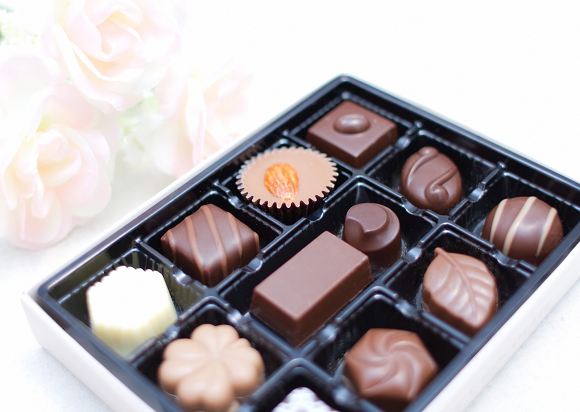
Despite the oppressive-sounding name, many see an upside to the practice.
Valentine’s Day in Japan is as much about the chocolate as it is about romance. But just as there are all sorts of romantic feelings, from a simple crush to a love that you feel from the bottom of your heart, so too are there many different classes of Valentine’s day chocolate in Japan.
In terms of volume, most of the chocolate purchased and given for Valentine’s Day is what’s known as giri choco, literally “obligation chocolate.” Giri choco doesn’t carry any significance of romantic love, but is instead given by women to their male coworkers and colleagues as a social nicety.
▼ Delicious duty
The Japanese division of multinational corporation 3M recently polled Japanese women about their giri choco plans, finding that out of 450 respondents, 39.8 percent planned on giving giri choco to a coworker this February. When asked why, the majority, 59.2 percent, said they’d be doing so to show their thanks for the general help and support they’d received from male coworkers throughout the year.
44.7 percent of also said they felt giri choco helped promote smoother workplace communication, and 18.4 also cited a simple desire to make the recipient happy as a reason. And down at number four on the list, 7.8 percent said they’d be giving giri choco this year simply because their female officemates were, and they felt going doing likewise was the least awkward option.
Regardless of the impetus, the average giri choco gift isn’t terribly expensive. 59.2 percent of the giri choco-giving respondents said they’ll be spending less than 500 yen (US$4.30) per person they plan to give some to, with another 34.1 percent budgeting between 501 to 1,000 yen per gift.
Also, while giri choco is commonly given at the office, women aren’t necessarily expected to give some to every male employee of the company, Often the gift-giving range is limited to teammates or people in the same division, and 68.2 percent of the gift-giving respondents will be buying giri choco for only one to five people, and only 12.8 percent will be handing out sweets to more than 10 guys.
Sifting through all those numbers means that many women are likely to be spending 2,500 yen or less for their giri choco activities, which isn’t a huge outlay. Still, hopefully their male coworkers will remember to return the favor one month later when White Day rolls around.
Source: PR Times
Top image: Pakutaso
Insert image: Pakutaso
[ Read in Japanese ]
Follow Casey on Twitter, where he’s happy to receive any delicious-looking photos of giri choco you care to send him, and will respond in kind for White Day.
[ Read in Japanese ]


 In Japan, women give “obligation chocolate” on Valentine’s Day, but do guys even want it?
In Japan, women give “obligation chocolate” on Valentine’s Day, but do guys even want it? Survey shows Japanese women would love to be getting some chocolate on Valentine’s Day too
Survey shows Japanese women would love to be getting some chocolate on Valentine’s Day too Is the coronavirus going to kill Japan’s obligation chocolate Valentine’s Day custom?
Is the coronavirus going to kill Japan’s obligation chocolate Valentine’s Day custom? Only one demographic in survey is happy about Japan’s workplace obligation Valentine’s chocolate
Only one demographic in survey is happy about Japan’s workplace obligation Valentine’s chocolate Tokyo opens entire store dedicated to helping women buy obligation chocolate for Valentine’s
Tokyo opens entire store dedicated to helping women buy obligation chocolate for Valentine’s Hayao Miyazaki says Happy New Year to Studio Ghibli fans with new art for Year of the Horse
Hayao Miyazaki says Happy New Year to Studio Ghibli fans with new art for Year of the Horse The best Starbucks Japan Frappuccinos we want to drink again in 2026
The best Starbucks Japan Frappuccinos we want to drink again in 2026 We revisited Sweets Paradise after a decade to see if Japan’s dessert buffet still delivers
We revisited Sweets Paradise after a decade to see if Japan’s dessert buffet still delivers Starbucks Japan unveils new S’mores Frappuccino and latte for Christmas 2025
Starbucks Japan unveils new S’mores Frappuccino and latte for Christmas 2025 Japan’s otoshidama tradition of giving kids money at New Year’s gets a social welfare upgrade
Japan’s otoshidama tradition of giving kids money at New Year’s gets a social welfare upgrade Shogun arrested in Japan for being a peeping Tom
Shogun arrested in Japan for being a peeping Tom Studio Ghibli releases Kodama forest spirits from Princess Mononoke to light up your home
Studio Ghibli releases Kodama forest spirits from Princess Mononoke to light up your home Japan’s oldest largetooth sawfish in captivity back on display in Mie Prefecture
Japan’s oldest largetooth sawfish in captivity back on display in Mie Prefecture More people in Japan quit sending New Year’s cards and many have started to regret it
More people in Japan quit sending New Year’s cards and many have started to regret it These are Osaka’s three best digital rail passes for travelers
These are Osaka’s three best digital rail passes for travelers Starbucks Japan ready to get Year of the Horse started with adorable drinkware and plushies【Pics】
Starbucks Japan ready to get Year of the Horse started with adorable drinkware and plushies【Pics】 Cyberpunk anime meets traditional culture in Ghost in the Shell gold leaf Japanese changing screens
Cyberpunk anime meets traditional culture in Ghost in the Shell gold leaf Japanese changing screens 7 great places to see Mt. Fuji from without having to climb it
7 great places to see Mt. Fuji from without having to climb it Hello Kitty Choco Egg figures are an adorable trip through three periods of Japanese pop culture【Pics】
Hello Kitty Choco Egg figures are an adorable trip through three periods of Japanese pop culture【Pics】 7-Eleven Japan’s ramen-cooking robot whipped us up a bowl of noodles【Taste test】
7-Eleven Japan’s ramen-cooking robot whipped us up a bowl of noodles【Taste test】 We found possibly the quietest Japanese-style hotel in Tokyo’s bustling Shinjuku district
We found possibly the quietest Japanese-style hotel in Tokyo’s bustling Shinjuku district Sumo Sanrio! Hello Kitty and pals team up with Japan Sumo Association for new merch【Pics】
Sumo Sanrio! Hello Kitty and pals team up with Japan Sumo Association for new merch【Pics】 More Than a Capsule Stay: Why Solo Travelers Choose “global cabin Yokohama Chinatown”
More Than a Capsule Stay: Why Solo Travelers Choose “global cabin Yokohama Chinatown” 7-Eleven Japan starts new temporary luggage storage service in over 300 branches
7-Eleven Japan starts new temporary luggage storage service in over 300 branches Disillusionment at Tsukiji’s tourist-target prices led us to a great ramen restaurant in Tokyo
Disillusionment at Tsukiji’s tourist-target prices led us to a great ramen restaurant in Tokyo Starbucks teams up with 166-year-old Kyoto doll maker for Year of the Horse decorations【Photos】
Starbucks teams up with 166-year-old Kyoto doll maker for Year of the Horse decorations【Photos】 Tokyo considering law requiring more trash cans following litter increase in heavily touristed area
Tokyo considering law requiring more trash cans following litter increase in heavily touristed area Tokyo’s Tsukiji sushi neighborhood asks tour groups to stay away for the rest of the month
Tokyo’s Tsukiji sushi neighborhood asks tour groups to stay away for the rest of the month Tokyo event lets you travel back in time, for free, to celebrate 100 years since Showa era start
Tokyo event lets you travel back in time, for free, to celebrate 100 years since Showa era start Sanrio theme park in Japan announces plans to expand into a Sanrio resort
Sanrio theme park in Japan announces plans to expand into a Sanrio resort Japan may add Japanese language proficiency, lifestyle classes to permanent foreign resident requirements
Japan may add Japanese language proficiency, lifestyle classes to permanent foreign resident requirements Stamina-destroying “Paralysis Noodles” are Tokyo’s newest over-the-top ramen innovation
Stamina-destroying “Paralysis Noodles” are Tokyo’s newest over-the-top ramen innovation Survey asks foreign tourists what bothered them in Japan, more than half gave same answer
Survey asks foreign tourists what bothered them in Japan, more than half gave same answer Japan’s human washing machines will go on sale to general public, demos to be held in Tokyo
Japan’s human washing machines will go on sale to general public, demos to be held in Tokyo Japan’s deadliest food claims more victims, but why do people keep eating it for New Year’s?
Japan’s deadliest food claims more victims, but why do people keep eating it for New Year’s? We deeply regret going into this tunnel on our walk in the mountains of Japan
We deeply regret going into this tunnel on our walk in the mountains of Japan Major Japanese hotel chain says reservations via overseas booking sites may not be valid
Major Japanese hotel chain says reservations via overseas booking sites may not be valid Put sesame oil in your coffee? Japanese maker says it’s the best way to start your day【Taste test】
Put sesame oil in your coffee? Japanese maker says it’s the best way to start your day【Taste test】 No more using real katana for tourism activities, Japan’s National Police Agency says
No more using real katana for tourism activities, Japan’s National Police Agency says Starbucks Japan reveals new sakura drinkware collection, inspired by evening cherry blossoms
Starbucks Japan reveals new sakura drinkware collection, inspired by evening cherry blossoms Updated cherry blossom forecast shows extra-long sakura season for Japan this year
Updated cherry blossom forecast shows extra-long sakura season for Japan this year Godiva runs full-page ad asking Japanese women to stop buying so much Valentine’s chocolate
Godiva runs full-page ad asking Japanese women to stop buying so much Valentine’s chocolate Giri? Tomo? Gyaku? A guide to Japan’s many different kinds of Valentine’s Day chocolate
Giri? Tomo? Gyaku? A guide to Japan’s many different kinds of Valentine’s Day chocolate Survey reveals Japanese men really want home-made chocolate, but are women willing to make it?
Survey reveals Japanese men really want home-made chocolate, but are women willing to make it? This Valentine’s Day, tell him you don’t love him with Japanese women’s “chocolate maggot” recipe
This Valentine’s Day, tell him you don’t love him with Japanese women’s “chocolate maggot” recipe How much Valentine’s Day chocolate do Japanese schoolgirls give, and to who?【Survey】
How much Valentine’s Day chocolate do Japanese schoolgirls give, and to who?【Survey】 Black Thunder shocks fans by suspending giri choco obligation chocolates on Valentine’s Day
Black Thunder shocks fans by suspending giri choco obligation chocolates on Valentine’s Day Don’t bother, ladies: Survey reveals most Japanese guys don’t want your Valentine’s chocolate
Don’t bother, ladies: Survey reveals most Japanese guys don’t want your Valentine’s chocolate Godiva takes swipe at Japan’s obligation chocolate king, Tokyo chocolatier fights fire with smile
Godiva takes swipe at Japan’s obligation chocolate king, Tokyo chocolatier fights fire with smile Giri obligation chocolates seen as power harassment, more Japanese companies ban practice
Giri obligation chocolates seen as power harassment, more Japanese companies ban practice President of Japan’s obligation chocolate king sends personal letter to giri choco-hater Godiva
President of Japan’s obligation chocolate king sends personal letter to giri choco-hater Godiva Survey suggests Tokyo women expect men to spend big on Valentine’s Day return gifts
Survey suggests Tokyo women expect men to spend big on Valentine’s Day return gifts Barely half of Japanese men in survey will give thank-you gift to women for Valentine’s chocolate
Barely half of Japanese men in survey will give thank-you gift to women for Valentine’s chocolate Give your loved ones stag beetle larvae and more this Valentine’s
Give your loved ones stag beetle larvae and more this Valentine’s Happy Virus-times! How has the pandemic affected Japan’s chocolate budget for Valentine’s Day?
Happy Virus-times! How has the pandemic affected Japan’s chocolate budget for Valentine’s Day?
Leave a Reply